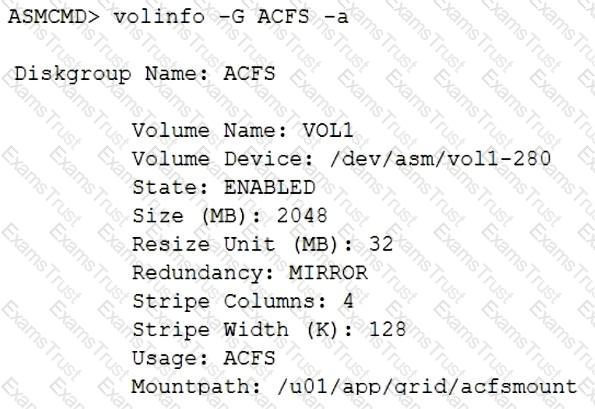Which two methods exist for enabling the collection of additional resource debugging information for specific resources controlled by Oracle 19c Clusterware? (Choose two.)
Which three statements are true about fully qualified file names in ASM? (Choose three.)
Which two statements are true about resources defined by an administrator and registered with Oracle 19c Clusterware for high availability? (Choose two.)
Which three statements are true about undo management in a RAC environment? (Choose three.)
Which two statements are true regarding ASM Dynamic Volume Manager (ADVM)? (Choose two.)
Examine the output of this command:

TheACFSdisk group is a normal redundancy disk group with 5 GB of free space.
To increase the size of theACFSfile system, you execute this command as therootuser:
$ /sbin/acfsutil size +200M /u01/app/grid/acfsmount
Which two statements are true regarding the outcome of this command? (Choose two.)
Which three statements are true concerning Automatic Database Diagnostic Monitor (ADDM) for RAC? (Choose three.)
Which three statements are true about diagnostic reporting for theOCRandOLRfiles? (Choose three.)
Which three statements are true about accessing ASM files? (Choose three.)
Which three statements are true about ASM Cloud File System (ACFS) replication? (Choose three.)
Which two statements are true concerning Oracle 19c Clusterware-managed application VIPs? (Choose two.)
Oracle Clusterware manages an administrator-managed database service defined with the MANUAL management policy.
Which two statements are true? (Choose two.)
Which three statements are true about the Oracle Clusterware 19c Flex Cluster architecture? (Choose three.)
You administer a six-instance, policy-managed, multitenant RAC database CDB1 with three PDBs: PDB_1,PDB_2, and PDB_3.
Server poolprod_poolhas a cardinality of three and all six hosts of the cluster are up.
Examine these commands executed on HOST01:

Which two statements are true regarding the AR service? (Choose two.)
Which three resources are managed using global concurrency control in an Oracle 19c RAC multi-instance database? (Choose three.)
Which two statements are true concerning buffer states as shown in GV$BH.STATUS in Oracle 19c RAC? (Choose two.)
Which two statements are true about server categorization in Oracle 19c Clusterware? (Choose two.)
Which three events occur when a node fails in an Oracle Clusterware 19c Cluster? (Choose three.)
Which four statements are true concerning the upgrading of Oracle Grid Infrastructure 19c? (Choose four.)
Which two statements are true concerning the installation of Oracle Grid Infrastructure 19c Cluster? (Choose two.)
Which task must be performed before running theOPatchutility to patch Oracle Grid Infrastructure 19c?
Which three statements are true concerning activation of a user-defined policy in Oracle 19c Clusterware? (Choose three.)
Which statement describes the usage of Dynamic Service Fallback in Oracle RAC 19c?